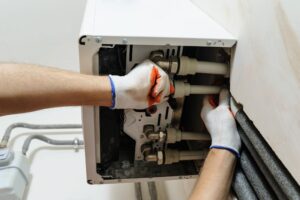Increase Energy Efficiency in Your Texas Home With the Right Improvement Projects
With its sweltering summers and rainy, windy falls, the Houston area doesn’t always make it easy to keep your home comfortable. If you want to keep the inclement weather out of your home, you’ll need to invest some time in improving its weatherization. There are many simple, affordable home improvements that can boost your home energy efficiency and, in turn, lower energy bills.
An Efficient Attic Benefits Your Whole Home
The condition of your attic has a major effect on your home’s ability to maintain a comfortable temperature. With the hot summer sun shining down on it, your attic can reach temperatures of 130 degrees or higher. Without good weatherization, that heat can enter air conditioned rooms by radiating through the attic floor and seeping in through cracks and gaps in the ceiling. That raises your home’s cooling load, forcing the air conditioner to expend more energy to remove the heat. Properly weatherizing the attic improves home energy efficiency by holding back the heat so attic ventilation can remove it from the attic.
A well-weatherized attic helps you in cold weather, too. Without good air sealing and insulation in the attic, warm air from the furnace will enter the attic and escape from your home through the roof.
Warm air entering a cold attic creates condensation. This moisture reduces insulation’s effectiveness and increases the risk of mold growth on the wood, drywall and insulation.
To raise your home energy efficiency and prevent these problems, you’ll need to seal the air leaks in the attic and ensure you have sufficient insulation. Air leakage comes from gaps and cracks around:
- The attic hatch
- Along the edges of the floor
- Behind kneewalls
- Penetrations for utility lines and vent stacks
- Furnace and water heater flues
- Dropped soffits
- Recessed lighting
Cracks of up to 1/4 inch can be sealed with latex acrylic caulk or another all-purpose caulk. For larger cracks of up to 3 inches, use spray foam insulation.
To seal around the appliance flues, you’ll need metal flashing to keep flammable materials away from the hot flue and silicone caulk to seal around the flashing.
If your home has recessed can lighting that must be kept away from the insulation, consider replacing the lights with non-perforated, IC-rated recessed lights. Both types can be sealed with caulk, but the latter can also be covered with insulation to more efficiently stop air leakage.
After air sealing, check that your attic has at least an R-35 layer of insulation, which is around 10 or 11 inches of batt insulation. If you have only 3 or 4 inches of batt insulation, you’ll need to add more to maximize your home energy efficiency.
Fiberglass batts are easy to install yourself without special equipment. Loose-fill cellulose requires a blower machine for installation, but this material fills in small crevices more efficiently. Mineral wool insulation, which is especially moisture-resistance, is another good option for insulating the attic.
Because the attic hatch is especially prone to leakage and heat exchange, add a layer of insulation to the top of the hatch door.
Tight Windows and Doors Save Energy and Improve Air Quality
If you’ve noticed your furniture needs frequent dusting, your home is uncomfortably humid in summer, and you’re plagued by cold drafts in winter, there’s a good chance your windows and doors could use some improvement. Even when you think they’re tightly closed, windows and doors can leak air through small cracks and gaps. In addition to letting in summer heat and humidity and wasting heat in winter, air leaks also let in air contaminants such as dust, pollen, and mold spores.
Sealing these air leaks raises your home energy efficiency, improves indoor air quality and protects you from chilly winter drafts. To find the leaks, wait for a breezy day and either puff baby powder into the air around the edges of the doors and windows or hold a lit incense stick up near these areas. Leaking air will visibly blow the powder or smoke. Sealing the leaks requires two different weatherization products: caulk and weatherstripping.
- Caulk – Caulk forms a hard seal, so it’s used to close cracks between non-moving surfaces, such as the window frames and the walls or around the door jamb. Latex and latex acrylic caulk work well on wood and other porous surfaces, but for metal window frames, silicone will create a more reliable seal.
- Weatherstripping – Weatherstripping is used to block air leaks between moving surfaces, such as door stops, the window stops of casement windows, and the tracks of double-hung windows.The type of weatherstripping you need depends on where you want to install it. Adhesive-backed foam provides a cheap and easy way to seal casement and sliding windows, and the tops and edges of doors. For double-hung windows, you can apply foam weatherstripping to the bottoms of the sash and V-strip weatherstripping in the tracks. Adding door sweeps to the bottoms of your doors further reduces air and dust infiltration.
Weatherized Walls Surround Your Home in Comfort
Just like windows and doors, walls can leak air through small cracks. All these air leaks combined amount to leaving a window wide open. Using the same technique you used to find other leaks, check for leaks around:
- Penetrations for utility lines (pipes, wires, etc.)
- Penetrations for exhaust fans and appliance vents
- Molding around your ceiling
- Baseboards around your floors
- Light switches and electrical outlets
- The fireplace
For cracks smaller than 1/4 inch, use latex acrylic caulk on wood and silicone caulk on metal and plastic. Gaps of up to 3 inches can be sealed with foam spray insulation. You may need to stuff larger gaps with scraps of insulation before sealing them.
The insulation in your walls is also important for your home energy efficiency. This insulation keeps out the summer heat and holds in the furnace’s warmth in winter. If your energy bills seem excessively high or if your walls feel cold in winter, contact a heating and cooling professional for a home energy audit. During this inspection, a heating and cooling technician can find insufficiently insulated walls using an infrared camera.
Well-Maintained Ducts Support Efficient Heating and Cooling
Investing your time and effort in raising your home energy efficiency only goes so far if your heating and cooling systems aren’t in good shape. Just having a high efficiency furnace or air conditioner isn’t enough. No matter how efficiently these systems operate, they still rely on the ducts to distribute heated or cooled air.
Most of your ducts’ energy loss occurs due to air leaks. Leaks in the ducts let conditioned air escape and draw in air contaminants from the attic and other spaces the ducts pass through. If your home seems usually dusty or if you have certain rooms that are hard to heat and cool, leaky ducts may be partly to blame.
Leakage occurs most commonly where the ducts connect to the air handler, to the registers and vents, and to each other. Make sure these connections fit tightly, then seal them with mastic duct sealant or foil-backed tape. Also check the fiberglass ductboard and flexduct for holes that could leak air.
Ducts in unconditioned spaces, such as the attic, can lose energy to the air around them. In summer, for example, the hot attic will heat up the air conditioned air passing through the ducts. To reduce this loss, install an R-6 layer of duct wrap insulation on the ducts in unconditioned areas. Alternatively, wrap the ducts in fiberglass batts and secure the batts with twine.
Basement and Crawl Space Weatherization
Your basement may not suffer from heat gain as much as the attic and walls, but it still needs proper weatherization. A poorly weatherized attic not only makes your floors cold in winter, but it also carries the risk of mold growth and pest infestations.
To block air leaks in the basement, use acrylic latex caulk, silicone caulk or expanding spray foam as appropriate to seal around windows, penetrations for utility lines and appliance vents, and the gap between the sill plate and foundation.
Use sections of rigid foam insulation to insulate rim joists in the spaces between the floor joints. Seal around each section with a bead of caulk.
Rigid foam can also be used to insulate the walls of your crawl space. Fiberglass and cellulose batts are poor choices for the crawl space because they retain moisture and encourage mold. To reduce moisture accumulation in the crawl space, spread a layer of 6 mm polyurethane sheeting on the floor and extend it 6 inches up the foundation walls. Seal the sheeting in place with expanding spray foam.
Learn more about home energy efficiency improvements available through Davis Air Conditioning & Heating, or contact us today at 888-929-0049 to schedule an appointment for your Houston area home.
Image Provided by Shutterstock.com
You May Also Like

HVAC System Installation in Rosenberg, TX?
Many homeowners buy a home with an HVAC system already installed, so upgrading or replacing an outdated system brings up a lot… Continue Reading HVAC System Installation in Rosenberg, TX?…

Have Your AC Tuned Up This Spring in Houston, TX
As the winter winds down and the weather begins to warm up, it’s a good idea for all homeowners in Houston, TX… Continue Reading Have Your AC Tuned Up This Spring in Houston, TX…

Questions to Ask An HVAC Contractor in Sienna Plantation, TX
Hiring an HVAC contractor in Sienna Plantation, TX, does not have to feel stressful or overwhelming once you’re familiar with the process… Continue Reading Questions to Ask An HVAC Contractor in Sienna Plantation, TX…
